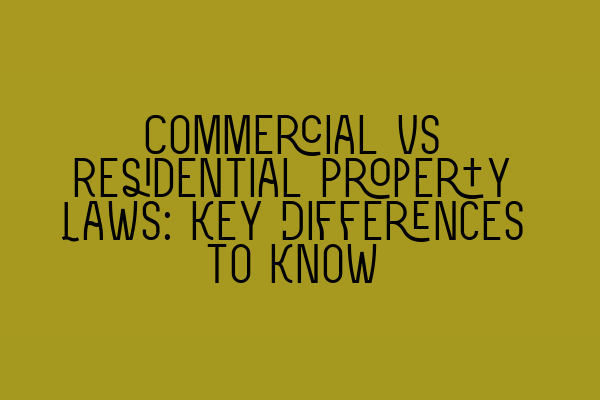Commercial vs Residential Property Laws: Key Differences to Know
When it comes to property law, there are distinct differences between commercial and residential properties. Whether you’re a property investor, landlord, or tenant, understanding these differences is crucial for navigating the legal complexities and ensuring compliance. In this article, we’ll explore the key differences between commercial and residential property laws in the UK.
1. Purpose and Usage
The primary distinction between commercial and residential properties lies in their purpose and usage. Commercial properties are typically used for business-related activities, such as offices, retail stores, industrial premises, and warehouses. Residential properties, on the other hand, are used for habitation by individuals and families.
It’s important to note that a property’s classification as commercial or residential can affect various legal aspects, including planning permissions, taxation, and landlord-tenant relationships.
2. Legal Framework
Commercial and residential properties are governed by different legal frameworks. Commercial property laws generally adhere to commercial law principles and are subject to meticulous contractual agreements, often involving leases, licenses, and complex negotiations. These laws prioritize business objectives and profit generation.
Residential property laws, on the other hand, are primarily focused on protecting the rights of tenants and ensuring safe and habitable living conditions. These laws are generally governed by housing and tenancy acts to ensure fair treatment and prevent exploitation.
It’s vital to seek professional legal advice from a property solicitor well-versed in the specific laws pertaining to your property type to ensure compliance and protect your interests.
3. Lease Agreements
Lease agreements for commercial and residential properties differ significantly. Commercial leases tend to be longer and more complex, often lasting several years. These leases often include detailed clauses regarding rent reviews, repair and maintenance responsibilities, break clauses, and assignments.
Residential leases, on the other hand, are generally shorter-term, typically lasting for six to twelve months. These leases come under the purview of housing regulations and tend to be more standardized, with fewer negotiable terms. Rent increase regulations and tenant rights play a more significant role in residential lease agreements.
Understanding the clauses and terms in lease agreements is essential to protect your rights and obligations as a landlord or tenant.
4. Property Taxes
Another key difference between commercial and residential properties lies in the taxation structure. Commercial properties are subject to business rates, which are calculated based on the property’s rateable value and vary depending on location and usage.
Residential properties, on the other hand, are subject to council tax, which is based on the valuation bands set by local authorities. These bands are determined by the property’s value as of 1991, with periodic adjustments.
Understanding the applicable tax requirements and seeking expert advice can help you effectively manage your tax liabilities and ensure compliance with the relevant regulations.
5. Building Regulations
Building regulations also differ for commercial and residential properties. Commercial properties are subject to more rigorous regulations due to their varied and extensive usage, particularly in areas of health and safety, fire safety, accessibility, and environmental impact.
Residential properties, while still subject to certain building regulations, have more specific guidelines regarding habitability, ventilation, electrical safety, and energy efficiency.
Working with architects, surveyors, and contractors who have expertise in the specific property type is crucial to ensure compliance with the applicable building regulations.
Conclusion
Understanding the key differences between commercial and residential property laws is essential for property investors, landlords, and tenants alike. By having a solid grasp of the legal framework, lease agreements, tax structure, and building regulations specific to each property type, you can navigate the complexities of property transactions and tenancy arrangements more confidently.
For comprehensive guidance on property law and staying updated with key changes and implications, check out our related articles:
- SQE Preparation for Property Practice: Mapping Out Your Strategy
- Updates in UK Property Laws: Key Changes and Implications
- Legal challenges in property transactions: A comprehensive guide
- Navigating Lease Laws in the UK: Essential Guidelines for Tenants and Landlords
- Dominate Property Law Questions: Avoiding Common Pitfalls
